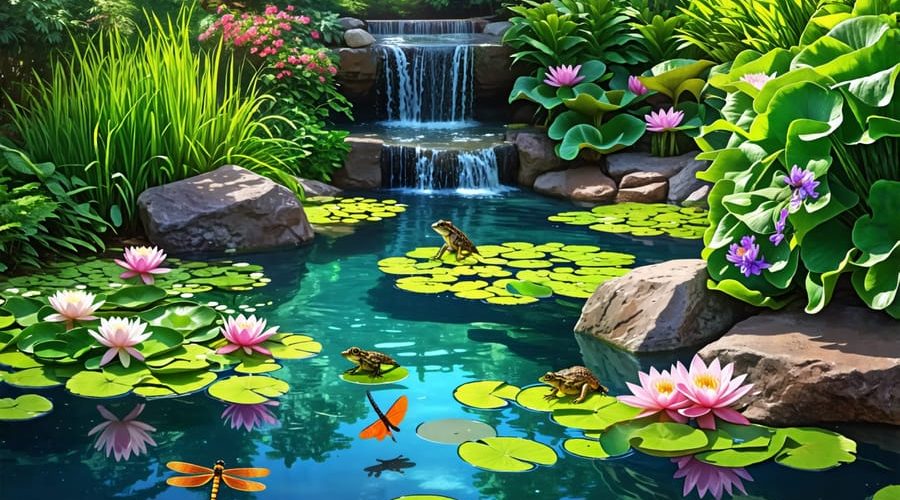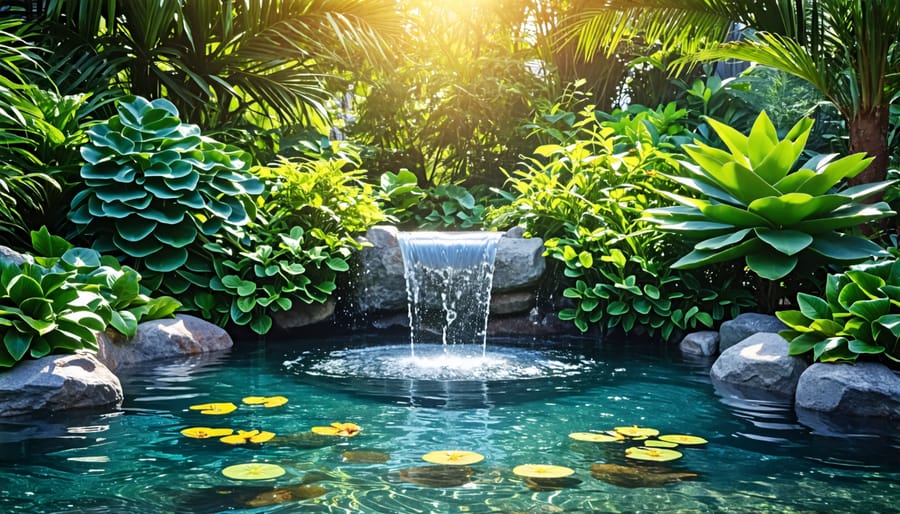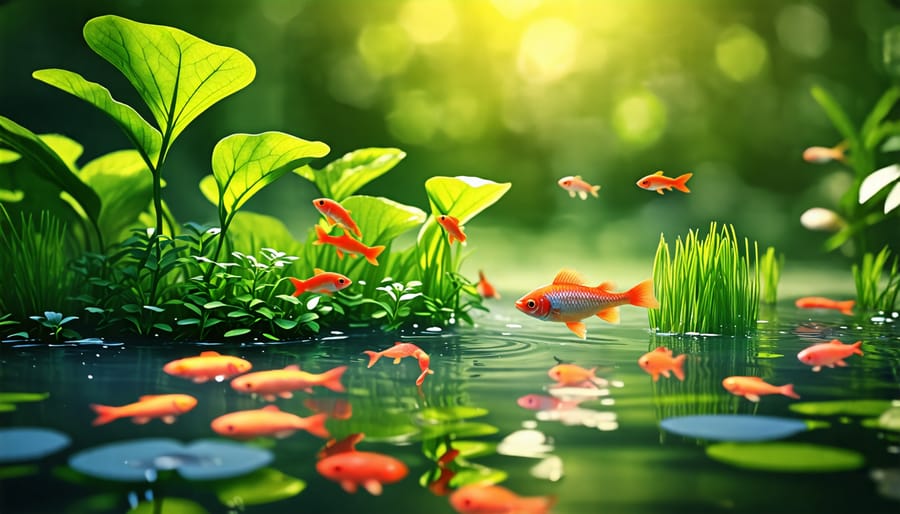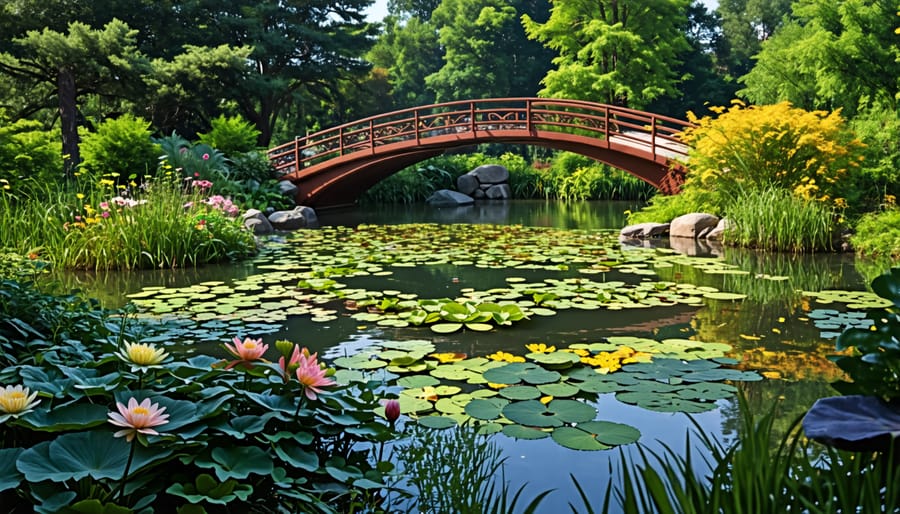
Turn Your Pond into a Lush Green Oasis: The Eco-Friendly Way
Plant native aquatic vegetation to establish a balanced pond ecosystem that filters water naturally and provides habitats for beneficial wildlife. Avoid using chemical herbicides or pesticides that can harm fish and amphibians; instead, control algae blooms by introducing submerged oxygenators like hornwort or floating plants like water lilies that shade the surface. Maintain crystal-clear water without harsh treatments by installing a combination of mechanical and biological filtration systems sized appropriately for your pond volume. Attract dragonflies, frogs, and other natural mosquito predators by incorporating diverse plant life in and around your pond, including marginal plants, floating species, and submerged varieties that create a thriving, multi-layered environment.
Understanding the Ecology of a Pond

The Role of Plants
Aquatic plants play a vital role in maintaining a healthy and balanced pond ecosystem. They act as natural oxygenators, releasing oxygen into the water through photosynthesis, which is essential for fish and other aquatic life. Pond plants also serve as biological filters, absorbing excess nutrients and pollutants from the water, helping to keep it clear and clean. The roots of submerged plants stabilize the pond bottom and prevent soil erosion. Moreover, aquatic vegetation provides crucial habitats and shelter for various pond inhabitants, such as fish, amphibians, and beneficial insects. Floating plants like water lilies offer shade, reducing algae growth and keeping the water temperature stable. Marginal plants along the edges create a transition zone between land and water, attracting wildlife and enhancing the pond’s aesthetic appeal. By incorporating a diverse selection of aquatic plants, you can create a thriving, self-sustaining ecosystem that supports a wide array of pond life.
Beneficial Bacteria and Microorganisms
In the unseen depths of your pond, a vibrant community of beneficial bacteria and microorganisms quietly works to maintain a healthy ecosystem. These microscopic heroes break down organic waste, such as fallen leaves and fish droppings, converting them into nutrients that nourish aquatic plants. By keeping the water clear and preventing the buildup of harmful substances, these tiny allies play a crucial role in maintaining the delicate balance of your pond. Encourage their growth by avoiding harsh chemicals and providing ample surface area for them to thrive, such as with the addition of rocks, gravel, and aquatic plants. As you marvel at the crystal-clear water and thriving pond life, remember to appreciate the invisible guardians that make it all possible.
Choosing the Right Plants for a Green Pond

Oxygenating Plants
Oxygenating plants are essential for maintaining a healthy pond ecosystem. Some top choices include submerged plants like hornwort, anacharis, and cabomba, which release oxygen directly into the water through photosynthesis. Floating plants such as water lettuce and water hyacinth also contribute to oxygenation while providing shade and filtration. For marginal areas, consider planting cattails, rushes, and pickerelweed, which absorb excess nutrients and help purify the water. When selecting plants, aim for a diverse mix of species to create a balanced environment. Remember to monitor plant growth and remove any excess biomass to prevent nutrient buildup. By incorporating these oxygenating plants into your pond, you’ll not only enhance its beauty but also create a thriving habitat for fish and other aquatic life. With proper plant selection and maintenance, you can enjoy a crystal-clear, eco-friendly pond that supports a vibrant ecosystem right in your own backyard.
Floating Plants
Water lilies, lotus, and floating hearts provide essential shade to keep water temperatures stable and prevent algae growth. These attractive plants also absorb excess nutrients from the water that would otherwise fuel algal blooms. Water hyacinth and water lettuce are fast-growing options that can quickly cover the surface, but require frequent thinning to prevent overcrowding. Floating plants with trailing roots, such as parrot’s feather and pennywort, create hiding spots for fish and other pond life. For a unique look, consider adding colorful options like floating sensitive plant or floating fern. By incorporating a diverse mix of floating plants, you can create a balanced, visually appealing pond that maintains a healthy ecosystem with minimal maintenance.
Marginal Plants
Marginal plants are essential for maintaining a healthy and beautiful pond ecosystem. Cattails, rushes, and sedges are excellent options that help filter runoff, absorb excess nutrients, and stabilize the pond edges. These plants also provide vital habitat for beneficial insects, amphibians, and birds. Pickerelweed and arrowhead add stunning color with their vibrant blooms while oxygenating the water. Consider planting moisture-loving perennials like cardinal flower, blue flag iris, and marsh marigold to enhance the pond’s aesthetic appeal. When selecting marginal plants, opt for native species well-suited to your climate and avoid invasive varieties that can quickly overtake the pond. By incorporating a diverse mix of marginal plants, you’ll create a thriving, eco-friendly oasis that naturally filters water and supports local wildlife.
Natural Pond Maintenance Tips
Harnessing Biological Filtration
To optimize biological filtration in your pond, strike a balance between beneficial bacteria and aquatic plants. Encourage the growth of aerobic bacteria by providing ample surface area, such as with filter media or porous rocks. These bacteria break down ammonia and nitrites, keeping the water clean. Regularly clean your filter media to prevent clogging, but avoid using harsh chemicals that can disrupt the bacterial colonies.
Aquatic plants play a crucial role in maintaining water quality by absorbing excess nutrients. Choose a mix of submerged, emergent, and floating plants to create a diverse ecosystem. Submerged plants like hornwort and anacharis oxygenate the water, while emergent plants such as cattails and rushes filter out pollutants. Floating plants, including water lettuce and water hyacinth, provide shade and compete with algae for nutrients.
Avoid overfeeding your fish, as uneaten food contributes to waste buildup. Stick to a regular feeding schedule and only provide what your fish can consume within a few minutes. Regularly remove debris like fallen leaves and decaying plant matter to prevent them from decomposing and releasing nutrients back into the water.
By fostering a thriving community of beneficial bacteria and carefully selecting aquatic plants, you can harness the power of biological filtration to maintain crystal-clear, healthy pond water naturally.
Preventing Algae Overgrowth
Preventing algae overgrowth in your pond is essential for maintaining a healthy, balanced ecosystem. While chemical treatments are available, opting for natural means is often more effective and environmentally friendly. One key strategy is to limit nutrients entering the water by avoiding overfeeding fish and removing decaying organic matter regularly. Planting a variety of aquatic vegetation helps absorb excess nutrients, while floating plants like water lilies provide shade, reducing sun exposure that fuels algae growth. Introducing beneficial bacteria through products like barley straw can also help break down organic waste and compete with algae for resources. Additionally, maintaining proper water circulation and aeration promotes a healthy oxygen balance, discouraging algae growth. By implementing these natural techniques and monitoring your pond’s ecosystem closely, you can keep algae in check and enjoy a crystal-clear, thriving water garden.
Seasonal Pond Care
As the seasons change, so do your pond’s needs. In spring, remove debris, divide overgrown plants, and gradually feed fish as water temperatures rise. Summer is prime for enjoying your pond, but keep an eye on water levels and filter health. When fall arrives, net falling leaves, trim dying plant material, and prepare fish for winter dormancy. In colder months, maintain a small opening in icy ponds for gas exchange and consider a heater or deicer. With season-appropriate care, your pond will thrive year-round while supporting the local ecosystem.
Enhancing Your Pond’s Ecosystem

Adding a Frog and Toad-Friendly Habitat
Attract frogs and toads to your pond by adding shallow ledges where they can bask and hide. Incorporate rocks, logs, and native plants along the edges to provide shelter and hunting grounds. Include some floating plants like lily pads for shade and resting spots. Avoid using chemicals, as amphibians are sensitive to pollutants. Create a small beach area with gravel or sand to allow easy access in and out of the water. Maintain a natural balance in your pond ecosystem, and these beneficial creatures will happily make themselves at home, controlling insects and adding to the biodiversity of your water garden.
Welcoming Dragonflies and Damselflies
To attract dragonflies and damselflies, create a diverse pond environment with varying depths and plenty of submerged and emergent plants. Include flat rocks around the pond’s edge where these insects can bask in the sun. Add vertical plants like reeds or tall grasses near the water to provide perches. Avoid using pesticides, as dragonflies and damselflies are sensitive to chemicals. Maintain good water quality, as these insects thrive in clean, well-oxygenated ponds. Consider adding a small fountain or waterfall to create movement and aerate the water. Be patient – it may take some time for these beautiful creatures to discover your pond paradise.
Conclusion
Creating your own eco-friendly green pond is a rewarding experience that benefits both you and the environment. By incorporating native plants, maintaining water quality through natural methods, and providing habitats for beneficial wildlife, you can establish a thriving aquatic ecosystem right in your backyard. Whether you have a small container pond or a larger in-ground feature, the principles of green pond environmental stewardship remain the same. With a little planning, care, and patience, you can enjoy the tranquility and beauty of your very own sustainable pond oasis while contributing to the health and biodiversity of your local environment. So, embrace the journey, get creative, and watch as your green pond comes to life!
